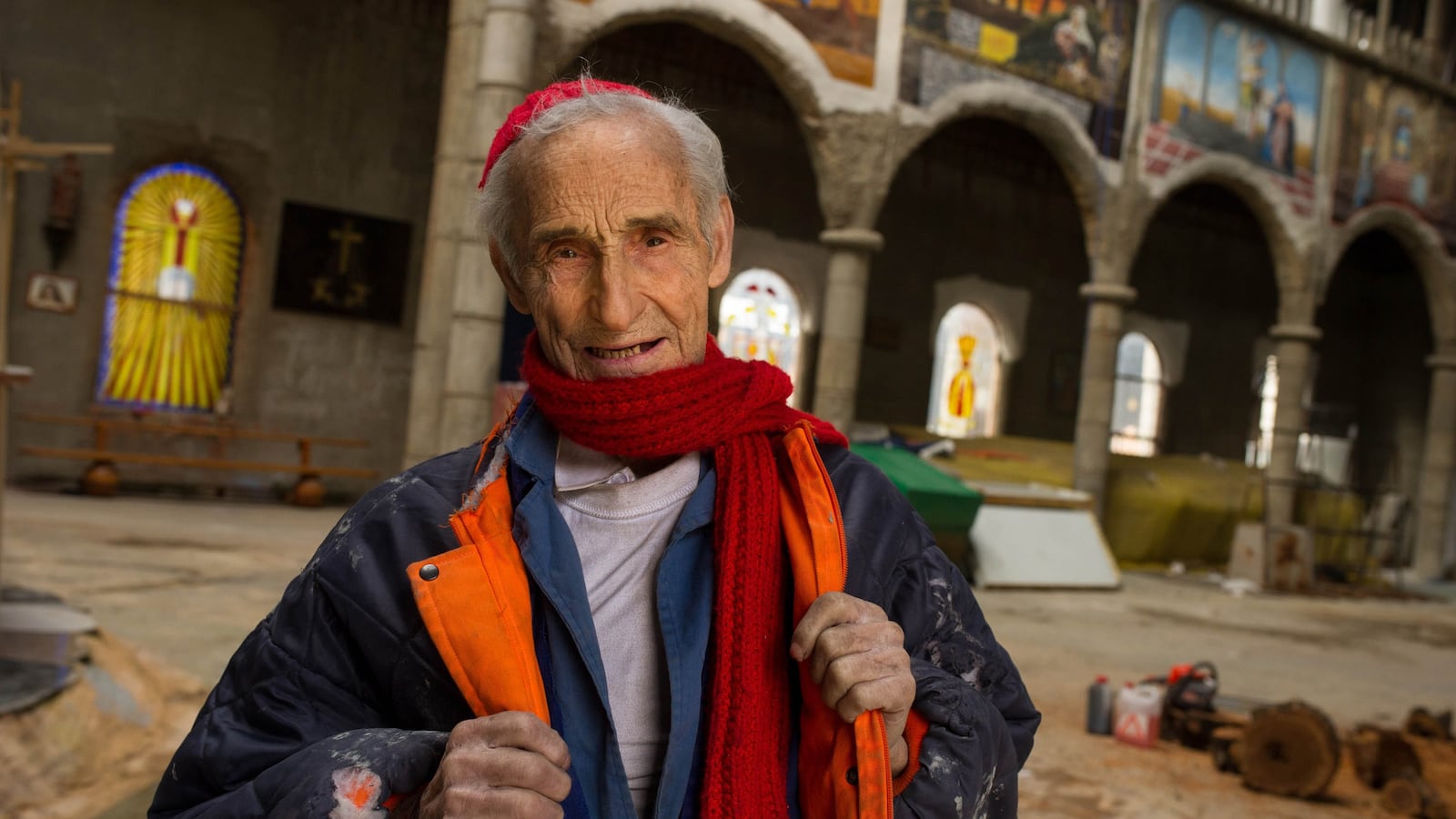In the blue-collar suburb of Mejorada del Campo, Spain, a 94-year-old ex-monk named Justo Gallego has been building a cathedral with his bare hands since 1961. He has no formal training as an architect, no construction permit, no endorsement by the Church, and no government funding—and yet, against all odds, he has erected a monumental temple that receives thousands of visitors each year.
The scale of the building is jaw-dropping: Picture a nave the size of two basketball courts surrounded by arcaded walkways and colorful frescoes. Portals on either side lead to two cloisters and four living quarters, presumably for monks. Twelve brick turrets tower above the roof. There are courtyards, chapels, stained glass windows, a crypt, and a cupola that reaches 130 feet. Gallego built all of this, virtually alone, brick by brick.

Former Trappist monk Justo Gallego collects a rope from the unfinished dome of his self-built cathedral on January 21, 2014.
Denis Doyle/GettyThe thing is, it’s nowhere near finished. There are building materials and scrap metal everywhere, and the central dome is nothing more than a metal skeleton, exposing the interior to the elements. With Gallego’s health ailing, his life’s work stands to be lost: Who, in his absence, will step up to finish the job? Will the government or Church intervene to protect the cathedral, or will it be bulldozed to make way for chain stores or shiny new condos for commuters?
The more I learned about Gallego’s cathedral, the more enthralled I became. This, I thought, was a tale that needed telling—before it was too late. So I tracked down Ángel López, Gallego’s right-hand man, and shot him a text to schedule an interview. His response caught me off guard: “How much are you willing to donate?”
Mejorada del Campo is situated 15 miles east of Madrid. Cathedral aside, it’s like any other Spanish suburb built in the postwar era. Low-rise apartments spoke out from a plain central square, where kids kick soccer balls and abuelos chit-chat on park benches. Laundry dangles from clothes lines above narrow, treeless sidewalks overgrown with weeds.
Gallego was a schoolboy here when the Spanish Civil War broke out. He watched in horror as the Republican forces razed religious buildings, their ruthless acts solidifying his Christian faith from an early age. At 26, he left Mejorada to become a Cistercian monk, only to be expelled eight years later due to a bout of tuberculosis. (It’s worth noting that one monk who studied with Gallego claims that he was dismissed because he “fasted and worked too hard,” adding that the other brothers “were worried about his health—above all, his mental health.”)
Back in Mejorada, with monastic life behind him, Gallego resolved to honor God in the only other way he knew, by building. He had inherited a plot of land on the outskirts of town, and there, he decided, he would erect a temple to the Virgin Mary. People in the village thought he was insane: How could a man with so little education and so few means construct a cathedral from scratch? “El loco de la catedral,” they called him, convinced that he’d fail.

Mural paintings on the arches are part of the decoration of the cathedral in Mejorada del Campo, Madrid, Spain, January 2011.
Cristina Arias/Cover/GettyBut Gallego was undeterred. He toiled day and night, hoisting bags of concrete and hauling truckloads of assorted scraps. Long before the term “sustainable construction” was coined, Gallego was fashioning battlements out of hairspray canisters and archways out of industrial springs. Tomato cans, water bottles, tires, soda cans—you name it, he found a place for it. Purportedly, some 90 percent of the building materials are recycled or reused.
As Gallego worked, he prayed constantly, remained celibate, and ate a sparse vegetarian diet. The asceticism ingrained in him at the monastery never left him. He devised his building plans not through physics or mathematics but rather through visions that came to him in prayer supplemented by tips from rudimentary architecture manuals.
What slowly rose from the rubble surprised everyone. The cathedral had a whiff of Gaudí to it—all rounded arches, brightly painted columns, and stained glass with pagan motifs. It was a window into a rich imagination. Orbs painted in gold and cobalt led the way to the entrance. “I love circles,” Gallego told the Spanish news network Telecinco. “It reminds me of planet Earth.”

A general view of the unfinished dome of the cathedral being built by former Trappist monk Justo Gallego on January 21, 2014 in Mejorada del Campo, Spain.
Denis Doyle/GettyBy the early 2000s, with much of the building’s framework in place, it was clear that Gallego’s cathedral was no folly. People wanted to know more about the hermit builder of Mejorada—how he worked, what made him tick. Spanish reporters started showing up with camera crews, and international institutions took notice, too: MoMA highlighted the building in a 2003-2004 exhibition. More fame came in 2005 with a far-reaching commercial for the soft drink Aquarius that spotlighted the cathedral. Suddenly, Gallego was a household name in Spain.
It was around that time that López (the guy who asked me to pay up) arrived on the scene. López, a Mejorada native, had long been fascinated by the cathedral and, on a whim, wandered over to the construction site. Gallego promptly put him to work. Fast-forward to the present, and López is Gallego’s trusty sidekick, the Sancho Panza to Gallego’s Don Quixote. They forged such a close bond over the years that López stands to inherit Gallego’s estate.
All of this I gleaned from scouring newspapers and watching old TV segments, not from speaking with Gallego face to face: Ultimately, López wouldn’t let me near Gallego after I refused his pay-for-play proposal. (My subsequent interview requests went unanswered.) López’s contrariness left a bad taste in my mouth, since “pay up or shut up” didn’t strike me as a particularly Christian attitude. No matter, I took the R-3 freeway to Mejorada, eager to immerse myself in Gallego’s fantasy world.
Churches are often the tallest buildings in small-town Spain, but Gallego’s cathedral looms over Mejorada like a ragtag Notre-Dame, its naked metal spires jutting high above the one-story houses below. As I got closer, the façade came into view, a jumble of bricks of all shapes and sizes stacked willy-nilly around an enormous blue rose window. Rounded red-painted steps slicked with moss curved lazily up to the entrance, which was, happily, open.
I stepped inside behind a family of four. Nobody greeted us—just a donation box beside a sign that read, “DO NOT ASK JUSTO ANYTHING. HE CAN’T TALK. ASK ÁNGEL ANY QUESTIONS.” Neither Gallego nor López were anywhere to be found. When I looked up and around, I had to blink a few times to believe what I was seeing—beyond the sheer magnitude of the space, which echoed with every footstep, there were bizarre bits and bobs everywhere. To my right, a chapel contained spray-painted busts of the Apostles. Behind me, mauve spheres adorned an altar bearing a motley crew of idols and crucifixes hung as if in a hurry. Then I noticed odder things: a rusting water boiler, yellowed mattresses, gilded mirrors, defunct TVs...
At first I was dumbstruck—it’s sobering to stand in such a sprawling building and realize that nearly every column, every stone, every brick, was put there by one sole person. But the more I explored, the more my admiration turned to concern. In one of the chapels, a gaggle of kids roughhoused unsupervised—mere inches from a mountain of broken glass and pointy rusted springs. Out in the cloister, a girl juggled a soccer ball beside a skein of electrical wires that passed through a puddle. In the second-story choir, I spotted a pothole-size gap in the floor covered only with chicken wire. Piles of dog shit sat decaying in the corners.
“This is a fantasy land for our kids,” a mother told me, gesturing toward her two boys inspecting a rock pile beneath the Disney-esque turrets. “It’s our third visit.” When I cracked a joke about forgetting my helmet, she laughed. “It’s a little scary, sure, but nobody’s ever gotten hurt here that I know of.” Just then, a chestnut fell through the open roof onto the floor behind us. Both of us jumped.

A general view of a section of the transept of the cathedral.
Denis Doyle/GettyThough the cathedral receives scores of visitors each day, it’s still private property under Spanish law—which means it doesn’t have to abide by the same safety codes as, say, a public museum. In fact, the cathedral has never been formally evaluated by a surveyor and is illegal by today’s standards, since no building license for the structure exists.
But Gallego’s defenders maintain that such permits weren’t required when he broke ground in 1961, and therefore shouldn’t apply today. A local official, who asked to remain anonymous, told me over the phone that Mejorada’s city hall “cannot prevent people from visiting the cathedral, just as it cannot prevent people from visiting anyone else’s private residence in Mejorada.” He added that, while the local government sees “no real danger” in allowing people to tour the cathedral, it would obviously be preferable that the building be adapted to current safety standards. Sadly there’s no budget for such a massive undertaking.
The lack of documentation—from blueprints to safety certifications to other necessary licenses—also precludes the cathedral from becoming, well, a cathedral—or even a church, for that matter, in the eyes of the local bishopric of Alcalá de Henares. Gallego’s dream, that his creation be an active place of worship (as opposed to a tourist attraction), is out of reach.

July 31, 2005
Gianni Ferrari/Cover/GettyIf the bishopric doesn’t want the cathedral and the town can’t afford to modernize it, what will happen when Gallego passes? That’s up to López, who has made vague promises about not allowing the cathedral to perish yet avoids the particulars of what that would entail. According to the town official, Mejorada has been in talks with a “UNESCO affiliate” about granting the building special status, which would ensure its survival and conservation. Whatever the cathedral’s fate, Gallego’s legacy will endure. This spring, he will be named Mejorada’s favorite son in a first-of-its-kind ceremony celebrating his contributions to the town. In the end, “el loco de la catedral” will go down as a local hero.
In the cathedral, in front of the main altar, a staircase winds down to a dank, unlit crypt. Beyond a sea of cement bags, tools, and paint buckets, there’s a long, deep hole cut into the earth. A modest wooden crucifix hangs above it and a shovel rests beside it—this is Gallego’s grave, which he dug himself. Ever a builder, he built his way into the afterlife, too.

